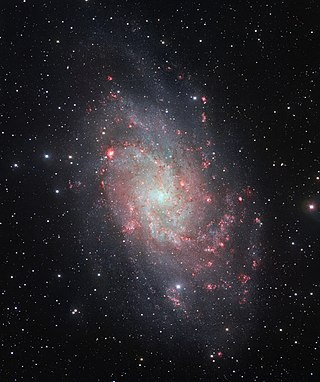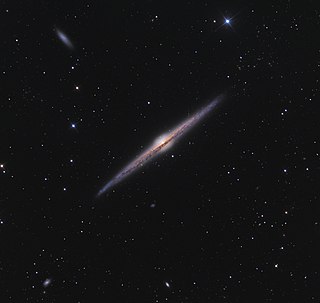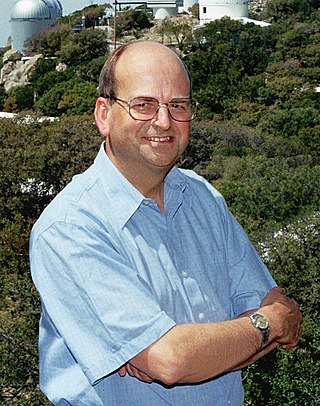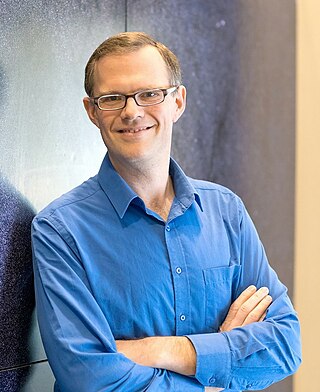
A globular cluster is a spheroidal conglomeration of stars. Globular clusters are bound together by gravity, with a higher concentration of stars towards their centers. They can contain anywhere from tens of thousands to many millions of member stars. Their name is derived from Latin globulus. Globular clusters are occasionally known simply as "globulars".

A galaxy cluster, or a cluster of galaxies, is a structure that consists of anywhere from hundreds to thousands of galaxies that are bound together by gravity, with typical masses ranging from 1014 to 1015 solar masses. They are the second-largest known gravitationally bound structures in the universe after galaxy filaments and were believed to be the largest known structures in the universe until the 1980s, when superclusters were discovered. One of the key features of clusters is the intracluster medium (ICM). The ICM consists of heated gas between the galaxies and has a peak temperature between 2–15 keV that is dependent on the total mass of the cluster. Galaxy clusters should not be confused with galactic clusters (also known as open clusters), which are star clusters within galaxies, or with globular clusters, which typically orbit galaxies. Small aggregates of galaxies are referred to as galaxy groups rather than clusters of galaxies. The galaxy groups and clusters can themselves cluster together to form superclusters.

The Andromeda Galaxy is a barred spiral galaxy and is the nearest major galaxy to the Milky Way. It was originally named the Andromeda Nebula and is cataloged as Messier 31, M31, and NGC 224. Andromeda has a diameter of about 46.56 kiloparsecs and is approximately 765 kpc from Earth. The galaxy's name stems from the area of Earth's sky in which it appears, the constellation of Andromeda, which itself is named after the princess who was the wife of Perseus in Greek mythology.

The Triangulum Galaxy is a spiral galaxy 2.73 million light-years (ly) from Earth in the constellation Triangulum. It is catalogued as Messier 33 or NGC (New General Catalogue) 598. With the D25 isophotal diameter of 18.74 kiloparsecs (61,100 light-years), the Triangulum Galaxy is the third-largest member of the Local Group of galaxies, behind the Andromeda Galaxy and the Milky Way.

Helen Battles Sawyer Hogg was an American-Canadian astronomer who pioneered research into globular clusters and variable stars. She was the first female president of several astronomical organizations and a scientist when many universities would not award scientific degrees to women. Her scientific advocacy and journalism included astronomy columns in the Toronto Star and the Journal of the Royal Astronomical Society of Canada. She was considered a "great scientist and a gracious person" over a career of sixty years.

Centaurus A is a galaxy in the constellation of Centaurus. It was discovered in 1826 by Scottish astronomer James Dunlop from his home in Parramatta, in New South Wales, Australia. There is considerable debate in the literature regarding the galaxy's fundamental properties such as its Hubble type and distance. NGC 5128 is one of the closest radio galaxies to Earth, so its active galactic nucleus has been extensively studied by professional astronomers. The galaxy is also the fifth-brightest in the sky, making it an ideal amateur astronomy target. It is only visible from the southern hemisphere and low northern latitudes.

The Milky Way is the galaxy that includes the Solar System, with the name describing the galaxy's appearance from Earth: a hazy band of light seen in the night sky formed from stars that cannot be individually distinguished by the naked eye. The term Milky Way is a translation of the Latin via lactea, from the Greek γαλακτικὸς κύκλος, meaning "milky circle". From Earth, the Milky Way appears as a band because its disk-shaped structure is viewed from within. Galileo Galilei first resolved the band of light into individual stars with his telescope in 1610. Until the early 1920s, most astronomers thought that the Milky Way contained all the stars in the Universe. Following the 1920 Great Debate between the astronomers Harlow Shapley and Heber Doust Curtis, observations by Edwin Hubble showed that the Milky Way is just one of many galaxies.

Bryan Malcolm Gaensler is an Australian astronomer based at the University of California, Santa Cruz. He studies magnetars, supernova remnants, and magnetic fields. In 2014, he was appointed as Director of the Dunlap Institute for Astronomy & Astrophysics at the University of Toronto, after James R. Graham's departure. He was the co-chair of the Canadian 2020 Long Range Plan Committee with Pauline Barmby. In 2023, he was appointed as Dean of Physical and Biological Sciences at UC Santa Cruz.

NGC 4565 is an edge-on spiral galaxy about 30 to 50 million light-years away in the constellation Coma Berenices. It lies close to the North Galactic Pole and has a visual magnitude of approximately 10. It is known as the Needle Galaxy for its narrow profile. First recorded in 1785 by William Herschel, it is a prominent example of an edge-on spiral galaxy.
George Henry Rieke, a noted American infrared astronomer, is former Deputy Director of the Steward Observatory and Regents Professor of Astronomy and Planetary Sciences at the University of Arizona in Tucson. He led the experiment design and development team for the Multiband Imaging Photometer for Spitzer (MIPS) instrument on NASA's infrared Spitzer Space Telescope, and currently chairs the science team of the Mid-Infrared Instrument for the James Webb Space Telescope.

Jeremy Richard Mould is an Australian astronomer currently at the Centre for Astrophysics and Supercomputing at Swinburne University of Technology. Mould was previously Director of the Research School of Astronomy and Astrophysics at the Australian National University and the American National Optical Astronomy Observatory. He is an Honorary Professorial Fellow, at the University of Melbourne.

Neta Bahcall is an Israeli astrophysicist and cosmologist specializing in dark matter, the structure of the universe, quasars, and the formation of galaxies. Bahcall is the Eugene Higgins Professor of Astronomy at Princeton University.
Christine D. Wilson is a Canadian-American physicist and astronomer, currently a University Distinguished Professor at McMaster University.

Marcia Jean Rieke is an American astronomer. She is a Regents' Professor of Astronomy and associate department head at the University of Arizona. Rieke is the Principal Investigator on the near-infrared camera (NIRCam) for the James Webb Space Telescope (JWST). She has also served as the deputy-Principal Investigator on the Near Infrared Camera and Multi-Object Spectrometer (NICMOS) for the Hubble Space Telescope (HST), and as the co-investigator for the multiband imaging photometer on the Spitzer Space Telescope, where she also acted as an outreach coordinator and a member of the Science Working Group. Rieke was also involved with several infrared ground-based observatories, including the MMT Observatory in Arizona. She was vice chair for Program Prioritization of the Astro2010 Decadal Survey Committee, "New Worlds, New Horizons". Marcia Rieke is considered by many to be one of the "founding mothers" of infrared astronomy, along with Judith Pipher.

Kim A. Venn is a professor of physics and astronomy at the University of Victoria, Canada, and director of the university's Astronomy Research Centre. She researches the chemo-dynamical analysis of stars in the galaxy and its nearby dwarf satellites.
Blakesley Burkhart is an astrophysicist. She is the winner of the 2017 Robert J. Trumpler Award awarded by the Astronomical Society of the Pacific, which recognizes a Ph.D. thesis that is "particularly significant to astronomy." She also is the winner of the 2019 Annie Jump Cannon Award in Astronomy and the 2022 winner of The American Physical Society's Maria Goeppert-Mayer Award. The awards both cited her work on magnetohydrodynamic turbulence, and for developing innovative techniques for comparing observable astronomical phenomena with theoretical models.

Peter Lawrence Capak is currently the Architect of Perception Systems at the Oculus division of Facebook. His current focus is developing machine perception technologies, sensors, displays, and compute architectures for the next generation of augmented (AR), mixed (MR) and virtual reality (VR) systems. His research has focused on using physical modeling and advanced statistical methods including artificial intelligence and machine learning to extract information from very large multi-wavelength (hyper-spectral) data sets. He has primarily used this to study structure formation in the universe, cosmology, and the nature of dark matter and dark energy.

Anne L. Kinney is an American space scientist and educator. Kinney is currently the Deputy Center Director at NASA Goddard Space Flight Center. Previously, she held positions as the head of the Directorate for Mathematical and Physical Sciences (MPS) for the National Science Foundation (NSF), the Chief Scientist of the W.M. Keck Observatory, Director of the Solar System Exploration Division at NASA Goddard Space Flight Center, Director of the Origins Program at NASA Jet Propulsion Laboratory, and Director of the Universe Division at NASA Headquarters. She earned a bachelor's degree in astronomy and physics from the University of Wisconsin-Madison and a doctorate in astrophysics from New York University, and has published more than 80 papers on extragalactic astronomy. She was an instrument scientist for the Faint Object Spectrograph that flew on the Hubble Space Telescope.
Sarah Connoran Gallagher is a professor of astronomy at the University of Western Ontario, where her research focuses on active galaxies, black holes and compact galaxy groups. From 2018 to 2022, she also served as Science Advisor to the Canadian Space Agency.

The Physics and Astronomy Building, historically known as the Science Building, is an academic building of the University of Western Ontario on its main campus in London, Ontario. The building was the one of two erected on the present campus site in 1922, with the other building being University College. The design is a good example of collegiate gothic architecture and its early use on the university campus and in the London area. In 2012, the building was renovated and awarded LEED Silver certification. It currently houses the Department of Physics and Astronomy.
















